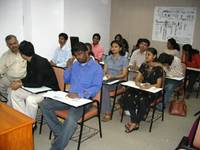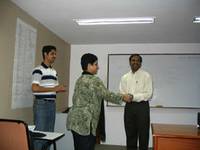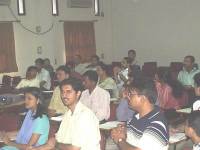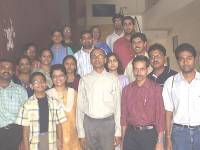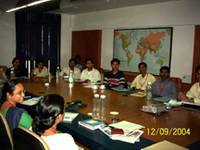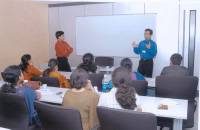The first STC learning session in January 2005 was a big success. This was the first learning that I organized as the Mumbai City Representative of the STC India Chapter.
Among the attendees was Gurudutt Kamath, the first president of the STC India Chapter.
 (l to r) Gurudutt Kamath, Vidyut, Richard H. Wallis, Sumathy Sreekumar
(l to r) Gurudutt Kamath, Vidyut, Richard H. Wallis, Sumathy SreekumarBeing Your Own Editor!
The workshop on editing by Richard Wallis of Oracle Corporation, California marked the beginning of Mumbai STC learning sessions for 2005. More than 30, senior and newbie technical writers attended this workshop sponsored by Tata Consultancy Services Ltd. on 29th January.
Richard started the session by stressing that both technical editors and writers could do technical editing effectively. A technical editor can ensure quality documentation by following the company's style standards. This helps to maintain consistency and eliminate errors, ambiguities, and misreading. Richard mentioned some of the benefits of using a style guide. Style guides can be used as a central repository for writing standards and guidelines.
A style guide can also:
- help groups work together.
- help in training new team members.
- Prove easier for translation.
Richard then explained each of the following:
- Hyphens
- Dashes
- Subject verb agreement
- Future tense
- Active and passive voice
- Lists
- Clear and concise sentences
Hyphens
Hyphens play a very important role while using prefixes and compound modifiers. Richard explained the different scenarios for using hyphens by providing ample examples.
Dashes
There are two types of dashes: En-dash and Em-dash. An "En-dash" is longer than a hyphen and used to separate words in compound sentences. An En-dash can also be used to divide numbers in a range, for example, see page 1-5. An "Em dash" is used to join parts of sentences. Typically, an Em - dash could be used when you need to set-off a phrase or clause that would require more emphasis than a parenthesis would provide.
Subject–Verb Agreement
There are different instances of using singular versus plural verbs. Words such as all, any, some, none, and what can be singular as well as plural.
The attendees took a break at this point. They made the most of the break by networking while savoring scrumptious sandwiches.
Future Tense
There is rarely a need to use the future tense and should be avoided. We should always use present tense in instructions and procedures. Future tense should only be used while defining objectives for readers and in legal language.
Active/Passive Voice
"Click Print to print the form" or "To print the form click Print." Which to use? Sounds confusing? Here, Richard explained the concept of active and passive voice with supportive examples. Active voice should be used when the subject of the sentence carries out action of the verb. Passive voice should be used when the receiver of the action is more important than the performer and the actual performer
is unknown.
Lists
Lists are frequently uses in technical writing. It is necessary to follow some rules while using the bulleted (unordered) and numbered (ordered) lists in any technical document. The first bullet should not be an introduction to the list and only one action should be described per step.
Richard then gave us some very insightful tips on writing clear, concise sentences for self-editing. The use of lengthy, complex sentences should be avoided at all times. Additionally, important information should be provided at the beginning of every sentence.
Attendees were then asked to edit long, confusing sentences. Every right answer was awarded with a chocolate bar. The workshop ended with a question and answer session. Senior technical communicators shared their editing experiences. They also discussed editing for American, British and Indian English audience. The learning session was very interactive and helpful as topics were explained with the help of substantial examples.
Report courtesy Swapna Shirwalkar


